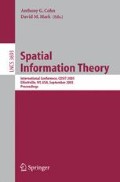Abstract
Current mobile computing systems can automatically sense and communicate detailed data about a person’s location. Location privacy is an urgent research issue because concerns about privacy are seen to be inhibiting the growth of mobile computing. This paper investigates a new technique for safeguarding location privacy, called obfuscation, which protects a person’s location privacy by degrading the quality of information about that person’s location. Obfuscation is based on spatial imperfection and offers an orthogonal approach to conventional techniques for safeguarding information about a person’s location. Imprecision and inaccuracy are two types of imperfection that may be used to achieve obfuscation. A set of simulations are used to empirically evaluate different obfuscation strategies based on imprecision and inaccuracy. The results show that obfuscation can enable high quality of service in concert with high levels of privacy.
Access this chapter
Tax calculation will be finalised at checkout
Purchases are for personal use only
Preview
Unable to display preview. Download preview PDF.
References
Beresford, A.R., Stajano, F.: Location privacy in pervasive computing. IEEE Pervasive Computing 2(1), 46–55 (2003)
Duckham, M., Kulik, L.: A formal model of obfuscation and negotiation for location privacy. In: Gellersen, H.-W., Want, R., Schmidt, A. (eds.) PERVASIVE 2005. LNCS, vol. 3468, pp. 152–170. Springer, Heidelberg (2005)
Duckham, M., Kulik, L., Worboys, M.F.: Imprecise navigation. GeoInformatica 7(2), 79–94 (2003)
Duri, S., Gruteser, M., Liu, X., Moskowitz, P., Perez, R., Singh, M., Tang, J.-M.: Framework for security and privacy in automotive telematics. In: Proc. 2nd International Workshop on Mobile Commerce, pp. 25–32. ACM Press, New York (2002)
Erwig, M.: The graph Voronoi diagram with applications. Networks 36(3), 156–163 (2000)
Gruteser, M., Grunwald, D.: Anonymous usage of location-based services through spatial and temporal cloaking. In: Proc. MobiSys 2003, pp. 31–42 (2003)
Gruteser, M., Grunwald, D.: A methodological assessment of location privacy risks in wireless hotspot networks. In: Hutter, D., Müller, G., Stephan, W., Ullmann, M. (eds.) Security in Pervasive Computing. LNCS, vol. 2802, pp. 10–24. Springer, Heidelberg (2004)
Hong, J.I., Landay, J.A.: An architecture for privacy-sensitive ubiquitous computing. In: Proc. 2nd International Conference on Mobile Systems, Applications, and Services, pp. 177–189. ACM Press, New York (2004)
Kaasinen, E.: User needs for location-aware mobile services. Personal and Ubiquitous Computing 7(1), 70–79 (2003)
Langheinrich, M.: Privacy by design - principles of privacy-aware ubiquitous systems. In: Abowd, G.D., Brumitt, B., Shafer, S. (eds.) UbiComp 2001. LNCS, vol. 2201, pp. 273–291. Springer, Heidelberg (2001)
Muntz, R.R., Barclay, T., Dozier, J., Faloutsos, C., Maceachren, A.M., Martin, J.L., Pancake, C.M., Satyanarayanan, M.: IT Roadmap to a Geospatial Future. The National Academies Press, Washington (2003)
Pfitzmann, A., Köhntopp, M.: Anonymity, unobservability, and pseudonymity - A proposal for terminology. In: Federrath, H. (ed.) Designing Privacy Enhancing Technologies. LNCS, vol. 2009, pp. 1–9. Springer, Heidelberg (2001)
Schilit, B., Hong, J., Gruteser, M.: Wireless location privacy protection. IEEE Computer 36(12), 135–137 (2003)
Snekkenes, E.: Concepts for personal location privacy policies. In: Proc. 3rd ACM conference on Electronic Commerce, pp. 48–57. ACM Press, New York (2001)
Worboys, M.F., Clementini, E.: Integration of imperfect spatial information. Journal of Visual Languages and Computing 12, 61–80 (2001)
Author information
Authors and Affiliations
Editor information
Editors and Affiliations
Rights and permissions
Copyright information
© 2005 Springer-Verlag Berlin Heidelberg
About this paper
Cite this paper
Duckham, M., Kulik, L. (2005). Simulation of Obfuscation and Negotiation for Location Privacy. In: Cohn, A.G., Mark, D.M. (eds) Spatial Information Theory. COSIT 2005. Lecture Notes in Computer Science, vol 3693. Springer, Berlin, Heidelberg. https://doi.org/10.1007/11556114_3
Download citation
DOI: https://doi.org/10.1007/11556114_3
Publisher Name: Springer, Berlin, Heidelberg
Print ISBN: 978-3-540-28964-7
Online ISBN: 978-3-540-32020-3
eBook Packages: Computer ScienceComputer Science (R0)

